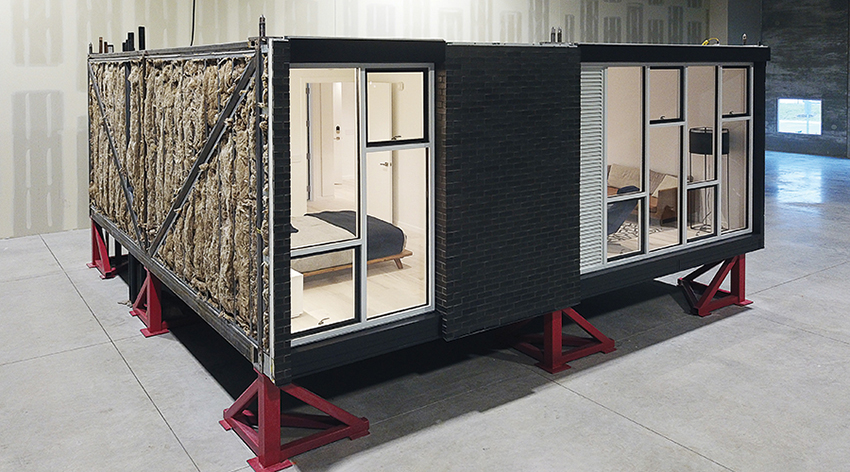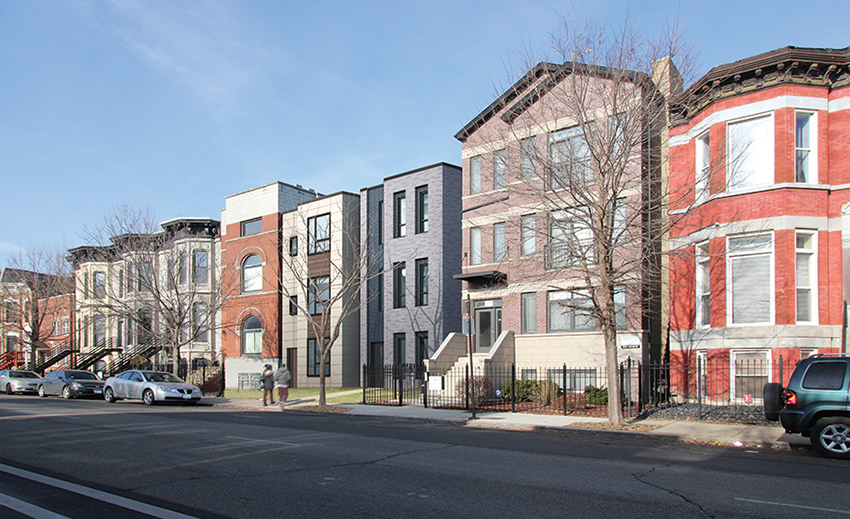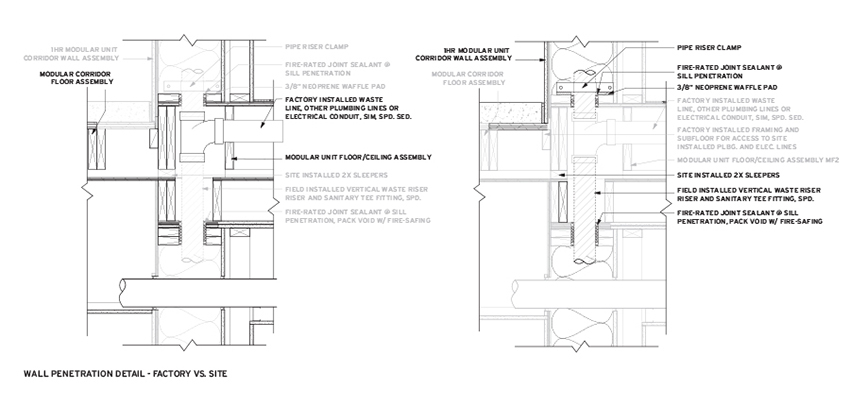Modular Construction
Integration has also led to the exploration of new tools and techniques, such as 3-D printing and robot-guided construction. On Skender’s paperless production line, instructions to the manufacturing floor feed directly from architectural and engineering CAD models. At Katerra, robots perform such tasks as maneuvering large-format sheathing panels onto framed walls, and cutting and fastening them with precision. In response to concerns that increasing automation may eliminate jobs, “I would argue that the demand for housing is beyond what can possibly be provided for using the systems we have available today,” Curtis says. “If we can improve the output per employee by using automation, it doesn’t necessarily reduce the number of jobs—it makes every job more effective.”
Although Katerra and Skender share a faith in the capacity of modular construction to tackle the housing crisis, they take contrasting approaches. Katerra exemplifies a flat-pack strategy, fabricating building elements such as structural frames, cladding panels, and systems-integrated floor, ceiling, and roofing panels, and shipping them as kits of parts to be assembled on-site. Skender takes a volumetric approach, in which three-dimensional modules of enclosed space are factory built and finished (right down to the TV on the wall, in the case of furnished units), and then stacked and connected on-site.
Flat-pack systems typically allow for greater flexibility and customization than volumetric modules, which are constrained by the dimensions that will fit on a truck. Volumetric modules, which in North America have been the more common method thus far, entail less site work, and so offer potentially greater efficiencies—especially if a factory floor where it’s 65 degrees and sunny year-round contrasts favorably with what’s outside.
With the exception of student and micro-housing, where small unit size and a high degree of standardization are well-suited to volumetric modules, a hybrid of flat-pack and volumetric systems will probably turn out to be optimal, says Michael Green, a principal at MGA. The firm’s Honeycomb Housing Prototype, a 29,300-square-foot development with 32 units, now in design for an urban infill site in Austin, Texas, provides an example.

VANCOUVER AFFORDABLE HOUSING AUTHORITY/MARK SIMPSON
Chicago-based Skender relies on steel-framed modules for its system, which is self-supporting up to 12 stories.
The project comprises five stories of mass-timber modular construction on a concrete podium. The flat-pack portion consists of CLT panels and glulam frames. The panels, with integrated acoustic insulation and m/e/p systems, are exposed on the underside as a structural wood ceiling and finished on top with a polished concrete floor. A panelized factory-built wood facade system and CLT-based composite roofing panels enclose the structure. Within the dwelling units, bathroom, bedroom, and kitchen pods are standardized to be factory built as volumetric modules and craned into place.
For Green, the best prefab doesn’t necessarily look prefab. “The whole point of a lot of the new technology is to move towards mass customization—not towards a highly repetitive world covered in Levittown-like housing, which is what people fear when they hear ‘prefabrication.’ ”
Whether flat-pack, volumetric, or hybrid, off-site fabrication of superstructure concurrent with site work, followed by ultra-speedy on-site assembly, shaves months off a project schedule compared with conventional construction. Skender can produce a fully finished module—including mechanical and electrical systems, finishes and fixtures, cabinets and countertops—of up to 600 square feet in five days, and can stack and bolt into place on-site eight to 12 modules per day. The system, which constitutes a steel moment frame, is self-supporting to about 12 stories.

VANCOUVER AFFORDABLE HOUSING AUTHORITY/MARK SIMPSON
In addition to a series of projects based on Chicago’s “three-flat” typology (rendering, above), Skender has six mid-rise buildings in design.
In addition to a series of infill projects based on Chicago’s “three-flat” typology, the company now has six mid-rise projects, ranging between four and 12 stories, in design. These include an 11-story, 110,000-square-foot mixed-use building with eight stories of modular housing on top of a site-built concrete podium and parking structure. From the time the podium is ready until all modular stories are set and bolted in place will take just seven and a half weeks. Joints between the volumes will then be sealed to maintain a continuous air and vapor barrier, a high-performance metal-panel facade will be applied, and cross-unit connections will be completed inside—a couple of months more in total.
Demonstrating what’s possible when a municipality fast-tracks an inherently fast production method, the housing authority of the city of Vancouver, British Columbia, recently developed 606 dwelling units for the formerly homeless in 13 buildings on 10 different sites in less than 18 months. That’s from the architects’ first meeting with the city to the last occupant permit’s being issued, says Anthony Boni, a principal with local Boni Maddison Architects, authors with design-builder Horizon North of all 13 projects. “Although speed was the main reason for choosing modular construction,” says Boni, “prefabrication gave us a major advantage in reducing disruption on-site,” especially useful when inserting a not always welcome use into existing neighborhoods. “We’ve had no complaints,” he says.

IMAGES: COURTESY SKENDER; DAVID BAKER ARCHITECTS
David Baker Associates uses side-by-side diagrams to distinguish work completed in the factory from that performed in the field. In one, the site work is ghosted to highlight the factory scope (above, left), while the other does the reverse (above, right).









